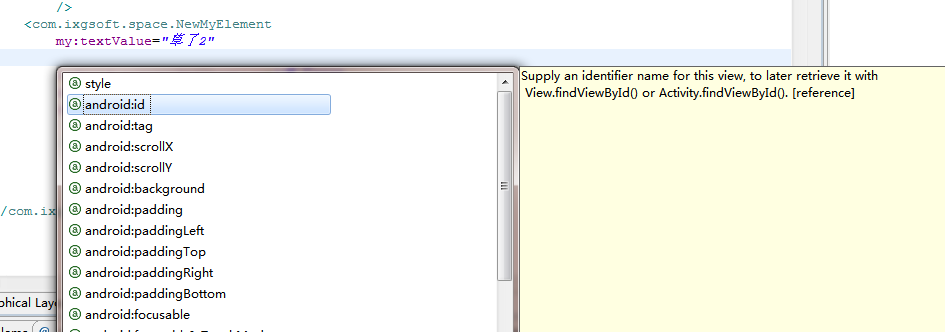自定义View自定义属性
来源:互联网 发布:python应聘有什么要求 编辑:程序博客网 时间:2024/04/29 22:35
在Android开发中常常需要自定义View,在自定义View后,常常需要一些特别的属性,这里一并讲解如何自定义属性。
1.自定义一个View类:MyNewElement.java
经过以上编码,就成功的创建一个自己的View类了。如果要把这个View类放到layout文件中,那么应该这样写:
在LinearLayout中,我定义了两个NewMyElement元素,注意,自定义的View类,在Layout布局文件中必须使用完全包名,我这里使用的是com.ixgsoft.space.NewMyElement。
2.创建自定义属性
在Android中要增加自定义属性,需要依靠attrs.xml文件。这里指定的自定义属性,是在layout布局文件中使用的不是以android开头的属性,例如my:textValue。
首先,我们需要在/res/values目录下新建一个名为 attrs.xml的文件。
这是一个android的resource文件,其中有一个域,名为 declare-styleable(声明属性)。这个域的有一个name属性为NewMyElement,这里很重要,这个name属性其实就是这个属性的在R类中的id。在这里域内部有3个attr域,他们都拥有两个属性,一个是name,代表这个属性的名字以及在layout布局文件中的调用名。format代表着这个属性的类型。这个属性怎么看呢?这里教大家一个方法。
在layout布局文件中,使用eclipse的提示功能(Alt+/),可以看到所有属性,这个时候按方向键,能够切换焦点,同时右部的提示也在变换。每一个android默认的属性,在提示的最后都有一个以[]包含的单词,这个就是这个属性的类型。
reference 资源类型,通常是@开头,例如@+id/xxxx,@id/xxxxx
string 字符串类型,通常是文字信息
dimension 浮点类型,通常是尺寸度量,单位有很多px,dp,sp,dip等
color 颜色类型,通常是颜色16进制代码,支持ARGB。
boolean 布尔类型,true和false
enum 枚举类型,通常是代表这个属性提供了几种值来进行选择,并且只能选择这几种中的一个
flag 与enum基本没有区别。
integer 整数类型,通常是整数
创建完attrs.xml文件,现在我们需要把这个属性用到layout文件中。
以上代码中,在根元素的中增加了一个额外的命名空间,xmlns:my="
http://schemas.android.com/apk/res/com.ixgsoft.space
"
最后的com.ixgsoft.space需要更改为你自己的包名。
做好之后,就可以在元素中使用以my开头的属性了,当然这里是没有Eclipse提示的,只能自己对照着写。
在init方法中,接收了一个AttributeSet 对象,然后使用getContext方法得到当前Context,调用Context.obtainStyledAttributes方法,传入AttributeSet 和R.styleable.NewMyElement,这里的R.styleable.NewMyElement,就是我们在attrs.xml中定义的名称,通过R.styleable来访问。
方法返回一个 typedArray对象。按照attrs,xml中定义的属性的类型,使用不同的get方法获取指定属性的值。看一看就懂了。
1.自定义一个View类:MyNewElement.java
package com.ixgsoft.space;import android.content.Context;import android.content.res.TypedArray;import android.graphics.Canvas;import android.graphics.Color;import android.graphics.Paint;import android.util.AttributeSet;import android.util.Log;import android.view.MotionEvent;import android.view.View;import android.widget.Button;import android.widget.TextView;import android.widget.Toast;/** * @Description: */public class NewMyElement extends View {private String TAG = "NewMyElement";private String text;public NewMyElement(Context context) {super(context);}public NewMyElement(Context context, AttributeSet attrs) {super(context, attrs);init(attrs);}public NewMyElement(Context context, AttributeSet attrs, int defStyle) {super(context, attrs, defStyle);init(attrs);}public void init(AttributeSet attrs){TypedArray t = getContext().obtainStyledAttributes(attrs,R.styleable.NewMyElement);String textValue = t.getString(R.styleable.NewMyElement_textValue);float textSize = t.getDimension(R.styleable.NewMyElement_textSize, 36);int textColor = t.getColor(R.styleable.NewMyElement_textColor, 0xff000000);}}经过以上编码,就成功的创建一个自己的View类了。如果要把这个View类放到layout文件中,那么应该这样写:
<?xml version="1.0" encoding="utf-8"?><LineanLayout xmlns:android="http://schemas.android.com/apk/res/android" xmlns:my="http://schemas.android.com/apk/res/com.ixgsoft.space" android:layout_width="match_parent" android:layout_height="match_parent" > <com.ixgsoft.space.NewMyElement my:textValue="草了1" android:layout_width="wrap_content" android:layout_height="wrap_content" /><com.ixgsoft.space.NewMyElement my:textValue="草了2" android:layout_width="wrap_content" android:layout_height="wrap_content" /></LineanLayout>
在LinearLayout中,我定义了两个NewMyElement元素,注意,自定义的View类,在Layout布局文件中必须使用完全包名,我这里使用的是com.ixgsoft.space.NewMyElement。
2.创建自定义属性
在Android中要增加自定义属性,需要依靠attrs.xml文件。这里指定的自定义属性,是在layout布局文件中使用的不是以android开头的属性,例如my:textValue。
首先,我们需要在/res/values目录下新建一个名为 attrs.xml的文件。
<?xml version="1.0" encoding="utf-8"?><resources> <declare-styleable name="NewMyElement"> <attr name="textColor" format="color" /> <attr name="textSize" format="dimension" /> <attr name="textValue" format="string" /> </declare-styleable></resources>
这是一个android的resource文件,其中有一个域,名为 declare-styleable(声明属性)。这个域的有一个name属性为NewMyElement,这里很重要,这个name属性其实就是这个属性的在R类中的id。在这里域内部有3个attr域,他们都拥有两个属性,一个是name,代表这个属性的名字以及在layout布局文件中的调用名。format代表着这个属性的类型。这个属性怎么看呢?这里教大家一个方法。
在layout布局文件中,使用eclipse的提示功能(Alt+/),可以看到所有属性,这个时候按方向键,能够切换焦点,同时右部的提示也在变换。每一个android默认的属性,在提示的最后都有一个以[]包含的单词,这个就是这个属性的类型。

reference 资源类型,通常是@开头,例如@+id/xxxx,@id/xxxxx
string 字符串类型,通常是文字信息
dimension 浮点类型,通常是尺寸度量,单位有很多px,dp,sp,dip等
color 颜色类型,通常是颜色16进制代码,支持ARGB。
boolean 布尔类型,true和false
enum 枚举类型,通常是代表这个属性提供了几种值来进行选择,并且只能选择这几种中的一个
flag 与enum基本没有区别。
integer 整数类型,通常是整数
创建完attrs.xml文件,现在我们需要把这个属性用到layout文件中。
<?xml version="1.0" encoding="utf-8"?><LineanLayout xmlns:android="http://schemas.android.com/apk/res/android" xmlns:my="http://schemas.android.com/apk/res/com.ixgsoft.space" android:layout_width="match_parent" android:layout_height="match_parent" > <com.ixgsoft.space.NewMyElement my:textValue="草了1" android:layout_width="wrap_content" android:layout_height="wrap_content" /><com.ixgsoft.space.NewMyElement my:textValue="草了2" android:layout_width="wrap_content" android:layout_height="wrap_content" /></LineanLayout>
以上代码中,在根元素的中增加了一个额外的命名空间,xmlns:my="
http://schemas.android.com/apk/res/com.ixgsoft.space
"
最后的com.ixgsoft.space需要更改为你自己的包名。
做好之后,就可以在元素中使用以my开头的属性了,当然这里是没有Eclipse提示的,只能自己对照着写。
3.在代码中调用自定义属性
package com.ixgsoft.space;import android.content.Context;import android.content.res.TypedArray;import android.graphics.Canvas;import android.graphics.Color;import android.graphics.Paint;import android.util.AttributeSet;import android.util.Log;import android.view.MotionEvent;import android.view.View;import android.widget.Button;import android.widget.TextView;import android.widget.Toast;/** * @Description: */public class NewMyElement extends View {private String TAG = "NewMyElement";private String text;public NewMyElement(Context context) {super(context);}public NewMyElement(Context context, AttributeSet attrs) {super(context, attrs);init(attrs);}public NewMyElement(Context context, AttributeSet attrs, int defStyle) {super(context, attrs, defStyle);init(attrs);}public void init(AttributeSet attrs){TypedArray t = getContext().obtainStyledAttributes(attrs,R.styleable.NewMyElement);String textValue = t.getString(R.styleable.NewMyElement_textValue);float textSize = t.getDimension(R.styleable.NewMyElement_textSize, 36);int textColor = t.getColor(R.styleable.NewMyElement_textColor, 0xff000000);}}在init方法中,接收了一个AttributeSet 对象,然后使用getContext方法得到当前Context,调用Context.obtainStyledAttributes方法,传入AttributeSet 和R.styleable.NewMyElement,这里的R.styleable.NewMyElement,就是我们在attrs.xml中定义的名称,通过R.styleable来访问。
方法返回一个 typedArray对象。按照attrs,xml中定义的属性的类型,使用不同的get方法获取指定属性的值。看一看就懂了。
- 自定义View自定义属性
- 自定义View自定义属性
- 自定义View自定义属性
- 自定义View自定义属性
- 自定义View自定义属性
- 自定义View-自定义属性
- 自定义View中自定义属性
- 自定义view的自定义属性
- Android自定义view自定义属性
- 自定义View之自定义属性
- 自定义View(1)------------自定义属性
- 自定义View以及自定义属性
- 自定义View-获取自定义属性
- 初学自定义view(自定义属性)
- Android自定义View-自定义属性
- 自定义view(自定义属性)
- Android自定义View-自定义属性
- 自定义View属性
- 浅议Windows 2000/XP Pagefile组织管理
- 这么多数据库组件,实际使用中会不会影响效率?
- repo 的用法和理解
- easyUI属性汇总
- step by step 安装svn for ubuntu
- 自定义View自定义属性
- ubuntu 安装svn
- jQuery Ajax 全解析
- Hibernate读书笔记-----hibernate第一个案例的分析
- luaplus windows环境下 VC6编译
- PNG透明背景按钮的实现(MFC)
- hdu 2845 Beans(dp)
- MyEclipse下XFire开发Webservice实例
- Bluez交叉编译移植到arm linux


